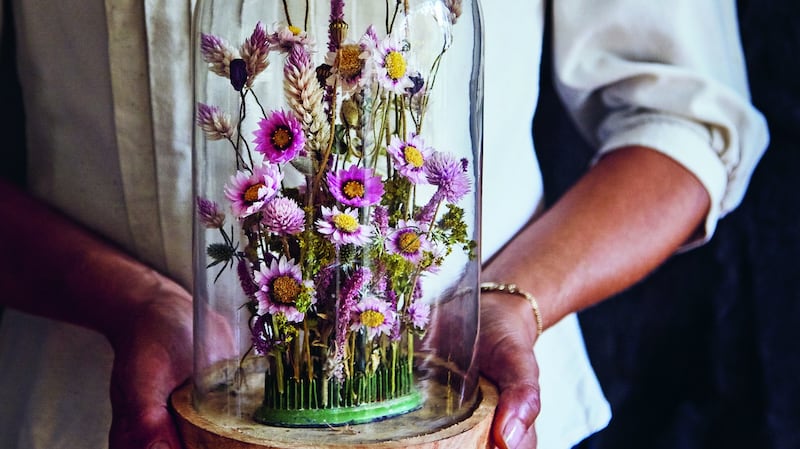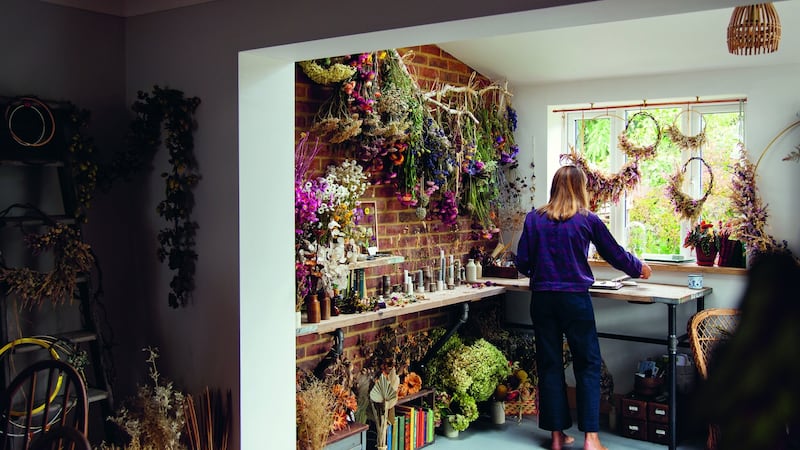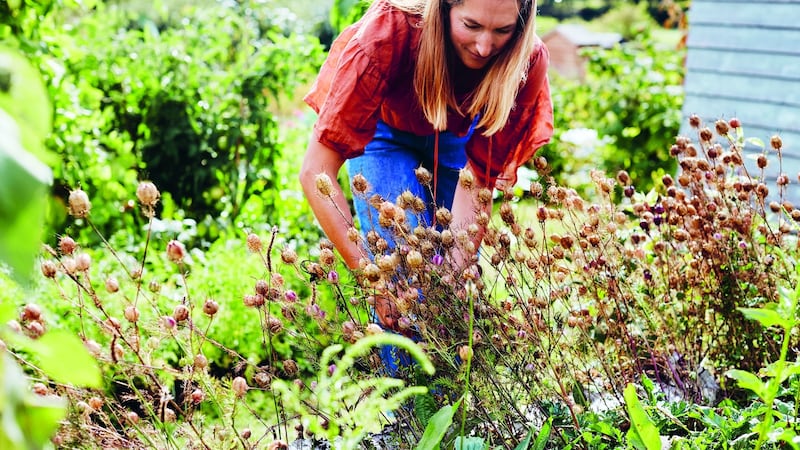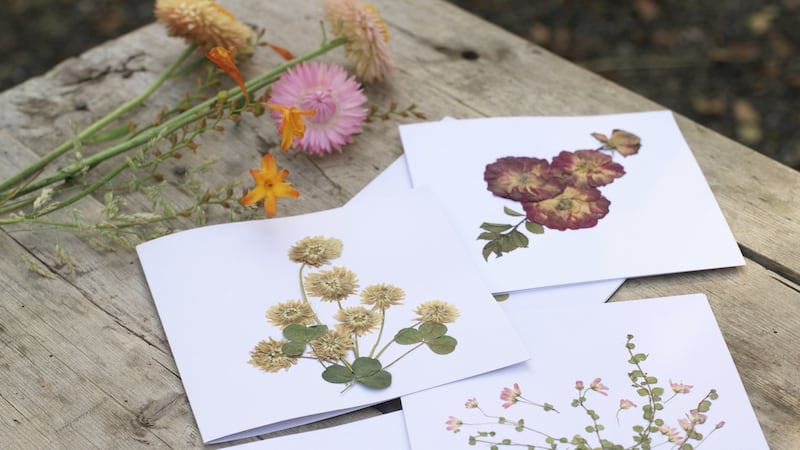Rather like the stuffed animal exhibits in Dublin’s Natural History Museum, I used to find the idea of dried flowers vaguely gloom-inducing. Those dusty, musty blooms, with their Miss Havisham-like sense of faded beauty just seemed a little sad.
But then slowly but surely something shifted. Instagram played an important part with its steady stream of images of beautiful bouquets, seasonal wreaths, table decorations, flower crowns and botanical mobiles, all artfully fashioned from dried foliage and flowers.
I started seeing gardeners and florists adding dried material to fresh bouquets and arrangements – a handful of wild ferns gently crisped to a shade of soft copper by an autumn frost, plummy hydrangeas, the silky flower plumes of miscanthus, the silver seed discs of honesty – and I couldn’t help noticing how they brought something very magical to the mix.

One of those leading the worldwide dried-flowers revival is English gardener and author Bex Partridge (@botanical_tales), whose book on the subject, Everlastings: How to grow, harvest and create with dried flowers (Hardie Grant) was published this summer. Filled with practical, hands-on information and advice gleaned from her first-hand experience of growing flowers and foliage for drying in her small garden and allotment in the south of England, it's an exquisitely illustrated, inspirational guide that showcases their special beauty in a very fresh and contemporary way.
I wouldn’t have thought, for example, of using dried grasses and foraged wildflowers – examples in her book include quaking grass (Briza maxima and Briza media), bunny’s tail (Lagurus ovatus), burnet (Sanguisorba) and wild cow-parsley seed heads – to create a mini meadowscape to decorate a dinner party table. Partridge’s book provies a step-by-step guide to doing exactly this.
Not only are the finished creations utterly charming but, as she points out, using locally grown dried flowers and foliage for these sorts of special occasions is also time-efficient (they can be prepared well in advance), cost-effective (they can be reused) and – during those cold, dark months of the year when fresh, homegrown blooms are hard to come by– far more sustainable than imported flowers.

Partridge’s table meadowscape is just one of more than 20 hands-on projects that feature in her book. Others include everlasting flower wreaths, autumnal wall hangings, pressed flower frames and various dried flower wearables from pretty dried flower crowns and floral combs to floral brooches and dried flower bracelets
The many creative possibilities of dried flowers aside, Partridge is excellent on the nuts and bolts of growing, harvesting and drying your own dried flowers as well as responsibly foraging for suitable material in the wild, explaining how many species are surprisingly easy to grow and dry.
Examples familiar to many Irish gardeners include lady’s mantle (Alchemilla mollis), achillea, feverfew (Tanacetum parthenium), curry plant (Helichrysum italicum), statice (Limonium sinuatum), strawflowers (Xerochrysum bracteatum, better known as Helichrysum bracteatum), globe thistle (Echinops ritro), Love-in-a-mist (Nigella) and any of the grasses mentioned above. All can be air-dried as simple hand-tied bunches hung upside down for a couple of weeks in a dry, dark room, attic space or airy cupboard.
Other flowers such as hydrangeas are better dried using what Partridge describes as the evaporation method, where the cut stems are placed in a vase with just a small amount of water and slowly left to dry out over time.

Pressing is another age-old technique that Partridge uses in inventive, space-efficient ways, pointing out that the average house is full of surprising possibilities in this regard. Larger flower stems and foliage such as delphiniums, ferns, oak, beech and acer branches that won’t fit into a conventional sized flower-press can instead be tucked between a few sheets of newspaper and then placed beneath a rug for a few weeks. “Alternatives are mattresses or any large objects that can apply pressure to the leaves,” she adds.
What plants can Irish gardeners harvest and dry at this time of year? Along with hydrangeas, teasels, wild rose hips, ferns and the branches of euacalyptus, oak, beech and acers, Partridge loves to gather the ornamental, autumnal seed-heads of perennials such as agapanthus and crocosmia.
“Just stick them upright in a container in a cool, dry, dark space indoors and they’ll gradually dry out all by themselves. Other favourites of hers to harvest at this time of year include the pliable stems of wild clematis, Virginia creeper and wild honeysuckle, all of which she uses to fashion the rustic structural bases for her seasonal wreaths.

“This is also a great time to sow seed of lots of different kinds of hardy annuals- examples include nigella, cornflowers (Centaurea cyanus) and Bishop’s flower (Ammi) which will give you lots of beautiful flowers and seed-heads to dry next summer,” says Partridge.
Like so many, the pandemic has radically changed the course of this English gardener, author and florist’s life in ways she could never have anticipated.
“At the beginning of the year my husband and I were planning a three-month trip in a caravan around the Nordic countries with our two young children. Covid put an abrupt stop to that. But in doing so, it galvanised us and made us reappraise why we’d wanted that time out in the first place. We came to the realisation that we wanted to live somewhere close to the sea where we were surrounded by the natural world and by a strong, like-minded community of creative, independent-minded people. So we put our house in Surrey up for sale and started searching online for the perfect place.”
That perfect place, their new home, is a house with its own half-acre rural garden on the Devon/Dorset border, not far from the town of Lyme Regis, into which they moved just a few weeks ago.
“Just a few short years ago I had a pretty soulless corporate job in marketing, which I gave up at the end of 2018,” says Partridge, whose book has recently been translated into German and Dutch. “It’s been an amazing journey.”
Everlastings by Bex Partridge (Hardie Grant, £14.99) Photography: Laura Edwards
This Week in the Garden
Killer frosts have hit many parts of the country in the past week, burning the flowers and foliage of tender plants and marking the arrival of autumn proper. Take advantage of any dry days to lift and compost dead annuals and quickly move under cover frost-tender shrubs/perennials, including standard fuchsias, argyranthemums, brugmansia, hedychium, plectranthus and pelargoniums.
Don’t miss the opportunity to use those freshly-emptied pots and tubs to create a colourful winter/early spring container display. Fill them with a mix of hardy, evergreen plants and spring-flowering bulbs to give plenty of seasonal interest throughout the coming months.
Examples include winter heathers, box, sarcococca, hellebores, trailing ivy, skimmia, heuchera, bay laurel, gaultheria, leucothoe, Carex testacea, Carex comans, Carex oshimensis ‘Evergold’, ‘Everglow’, ‘Everillo’ and ‘Everest’, the black-leaved ‘Ophiopogon planiscapus ‘Nigrescens’, evergreen ferns such as Polystichum setiferum and Polypodium vulgare, crocus, eranthis, dwarf daffodils, anemones, snowdrops, tulips and muscari.
Buy or order and then pot up the fleshy bulbs of amaryllis (properly known as hippeastrum) in the coming weeks to give to friends and family as flowering plants this Christmas. Most good Irish garden centres stock the bulbs at this time of year along with online suppliers including Mr Middleton and specialist suppliers such as UK-based Parkers Bulbs (jparkers.co.uk).
It typically takes seven or eight weeks for the bulbs to flower once they’re shallowly planted into pots and then placed somewhere bright and warm but not in direct sunlight (a bright windowsill in a warm room with an ambient temperature of 16-21 degrees is ideal).

Check this out
Using sustainably harvested, hand-pressed Irish wild flowers, grasses and leaves gathered in her own garden in Dunquin , Margaret Dineen's Dúlra cards open a window into the beauty of west Kerry's hidden wild corners. To order, email andulra20@gmail.com or message her on Instagram @An_dulra.














